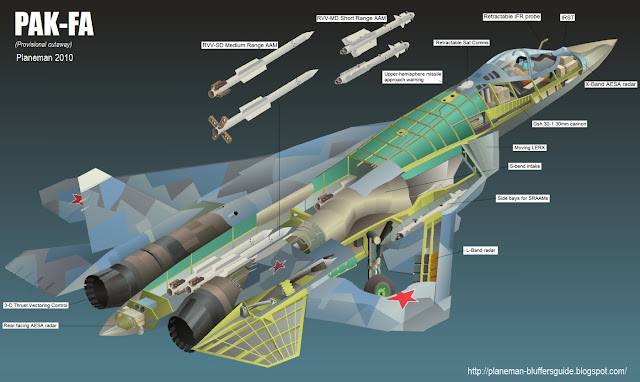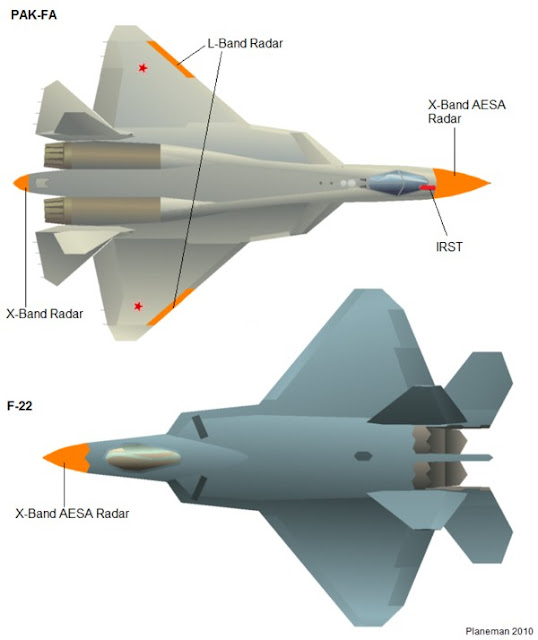Comparison: Is PAK FA The Raptor killer?
It has been suggested that for the PAK-FA to be successful it does not need to exceed the F-22, merely come close enough to shift popular perception of the F-22’s unrivaled dominance of the 5th Generation stage. There will always be die-hard proponents of both planes and any definitive analysis is certainly premature. The following observations should be taken within the context of amateur analysis based on scant reliable information. I think it makes little sense to dive into details, any meaningful comparison must remain high-level.
Stealth: There can be no serious doubt that the PAK-FA is a stealth aircraft; stealth shaping is a compromise and the T-50 clearly shows design decisions which make no sense if stealth was not the aim. Frontal aspect stealth is likely very good.
The rear of the engine nacelles has more questionable stealth however and suggests a focus on frontal aspect stealth with rear aspect-stealth clearly being a feature but less-so than F-22. Alternatively the engine nacelles may be remodeled when the production standard engine is introduced (the prototype likely flew with interim Saturn 117S engines to reduce risk).
PAK-FA clearly uses shaping to deflect radar waves, and presumably will be painted in a RAM paint. It may also employ ‘Plasma stealth’, particularly within radomes. Although the cockpit canopy is sloped as per the F-22s (ie not ‘bubble’

, it is not clear if it is radar reflecting like the F-22’s, and does not have the brown tinge of gold-lined cockpits. Radomes and cockpit canopies are said to be amongst the most difficult parts of an aircraft to make stealthy and it may be that this technology is proving more difficult to develop.
Both aircraft are credited with super-cruise, the ability to fly at supersonic speeds without using afterburner, and thus increasing range and reducing heat signatures compared to other fighters at equivalent speeds.
Air-Air Weapons: Russia has unveiled the RVV-SD missile, an updated version of the AA-12 Adder missile with folding fins, as the main missile of the aircraft. Although the PAK-FA’s weapons bays can likely carry larger missiles, they are probably not large enough for the massive KS-172 (RVV-L) weapon which has an expected range of about 400km.
Reports indicate that this missile, or one with similar performamce, can be carried externally. The ramjet powered version of the AA-12 Adder promoted in the 1990s seems to have been dropped. The RVV-SD is likely a good match for the latest AMRAAM variants, though both may be eclipsed by the ramjet powered long range Meteor missile which will be fielded on ‘Eurocanards’ like the Gripen and Typhoon by the time PAK-FA enters service.
The above comparison with the F-22 shows the larger main weapons bays of the PAK-FA (red). The F-22 can carry 6 AMRAAM missiles in the main bay. Reports indicate that the PAK-FA can carry 8 equivalent AA-12 (RVV-SD) missiles, giving it a 2 missile advantage. The side bays (orange) are of similar capacity with both aircraft carrying just one short-range missile per bay.
For the PAK-FA the two smaller weapons bays are probably for the RVV-MD version of the AA-11 Archer short range missile. The RVV-MD is probably capable of rear-firing, a unique feature whereby the missile flips immediately after launch and flies at a target behind the plane. AA-12s with this feature have been tested and are possibly operational within the Flanker community.
The F-22 is currently equipped with relatively outdated AIM-9 variants, and lacking a helmet mounted sight for off-boresight targeting. This is likely to be rectified before the PAK-FA enters full scale service and so F-22 and PAK-FA will likely be closely match in this technology.
Both aircraft are equipped with a single cannon; 20mm Vulcan for the F-22 and probably a Gsh-30-1 (as per the Flanker) for the PAK-FA. Many reports suggest that PAK-FA will have two cannons but this seems unlikely and the T-50 prototype appears to only have one gun port, situated on the starboard forward fuselage.
Air-Ground role: The F-22 started life as a straightforward air superiority fighter (later rebranded “Air Dominance”

but has been evolved to carry a potent strike capability. Part of the drive towards the multirole capability was the conspicuous absence of a credible “5th Generation” air threat from the Russian side. The F-22 was conceived in the 1980s against the background of the cold war, facing off to a generation of Soviet fighters which never came.
For a while the F-22 looked somewhat spare and a strike capability was added, made possible by US advances in GPS weaponry. The F-22’s internal weapons bays were not large enough for substantial loads so special smaller-diameter bombs have been developed. The F-22’s air-ground weapons load is modest to say the least, but its ability to deliver them to the target seems unrivalled and more than makes up for this deficiency.
The PAK-FA too is reportedly a multi-role design. The internal weapons bays appear larger than on F-22, but are of unconfirmed depth and may not be capable of carrying many of the weapons speculated.
Various Kh-31 (AS-17 Krypton) family supersonic missiles seem plausible albeit on the large side, as do satellite guided bombs and KAB-500 series bombs. The weapons bays are about 5m long.
A folding fin version of the Kh-58 ‘Kilter’ anti-radiation missile has been shown and this seems a reasonable fit, though may be more relevant to the MiG SKAT UCAV program rather than the PAK-FA.
Avionics: The PAK-FA has several features of particular interest here. In the nose there is likely to be active electronically scanned array radar (AESA) as per F-22.
This may actually have additional mechanical steering, although that would add weight. What’s virtually unique to the PAK-FA however is rear-facing radar in the tail. This too may be AESA and could simply be an additional array for the nose-mounted radar, or possibly a completely separate set.
The PAK-FA therefore has true 360 degree coverage. Additionally the PAK-FA is thought to have L-Band radars mounted in the wing leading edges. These would have both passive and active emitting roles and may be the key to ‘seeing’ stealth aircraft such as the F-22. Alternatively these may be located in the wing LERX sides – the exact location is subject to some speculation.
The F-22’s stealth is generally optimized against X-band radars as that is what fighters generally use – L-Band is a much longer wavelength and can more easily detect stealth aircraft but is also less accurate -hence X-band radars are still used for routine intercept and virtually all fighters use X-Band.
There is serious doubt of Russia’s ability to mass produce key computer components such as micro processors. This may prove a deployment bottleneck, or Western off-the-shelf processors may be used. Russia has proven capability to produce Phased array radars, datalinks etc and may attempt to sidestep technological deficiencies.
Unlike the F-22 the PAK-FA will feature an IRST optical/IR search and tracking system. The decision not to fit an IRST to the F-22 may be reconsidered to rectify this gap. IRST promises to be the best way to target stealth aircraft since regardless of the IR stealth claims made of the F-22, jet engines are fundamentally not conducive to IR invisibility. The trail of hot air behind the F-22 is likely the first thing the PAK-FA may see, perhaps as far as 25km.
Sukhoi’s recent demonstration cockpit mock-ups, which may relate to both Su-35 or PAK-FA, suggest two very large multi-function-displays (MFDs) and a very wide Head-up-display (HUD). The T-50-1’s cockpit clearly has the massive HUD. If this mock-up cockpit is essentially similar to PAK-FA’s, then compared to the F-22 the PAK-FA’s will take advantage of advancing technologies of past decade and be relatively more advanced than F-22s.
The F-22 has 4 large and two small MFDs and a large HUD, but PAK-FA’s two displays are much larger still and the HUD even bigger:
Dogfighting: The F-22 is exceptionally maneuverable, but comparatively less dogfight optimized compared to the PAK-FA which has 3D thrust vectoring and moving LERX. This seems in line with Russian doctrine still influenced by the Syrian experiences over the Baka Valley in 1981 where Soviet supplied fighters were decimated by the Israeli air force in close combat.
It seems probable that the PAK-FA is more maneuverable, but the F-22 may have speed-bleed/regain advantages.
The F-22 has larger wing leading-edge flaps and larger tail planes. The PAK-FA’s tail fins are smaller but all-moving and the 3D TVC allows the engines to be used both laterally and horizontally unlike the F-22 which relies on massive tail fins for lateral stability and yaw control.
Export market : This in my eyes is by far the most impactful difference. PAK-FA is intended to be exported, both via the related Indo-Russian FGFA program (a two seat Su-30MKI replacement) and in the general export market. Within the latter, the most probable customers in my eyes (as of 2010 geo-politics) are Brazil, Venezuela, Belarus, Libya, Angola, Vietnam and Saudi Arabia. Syria is never likely able to afford it and Iran is likely to fall from favor.
Therefore the most probable actual air-air adversary, and sales competitor, is the F-35 not the F-22; production of the F-22 is scheduled to stop with just 187 operational airframes and no exports. PAK-FA is also likely to be operated in relatively small numbers, but by many more air forces.
CREDITS ( Original Source ) :
Here




 , it is not clear if it is radar reflecting like the F-22’s, and does not have the brown tinge of gold-lined cockpits. Radomes and cockpit canopies are said to be amongst the most difficult parts of an aircraft to make stealthy and it may be that this technology is proving more difficult to develop.
, it is not clear if it is radar reflecting like the F-22’s, and does not have the brown tinge of gold-lined cockpits. Radomes and cockpit canopies are said to be amongst the most difficult parts of an aircraft to make stealthy and it may be that this technology is proving more difficult to develop.











